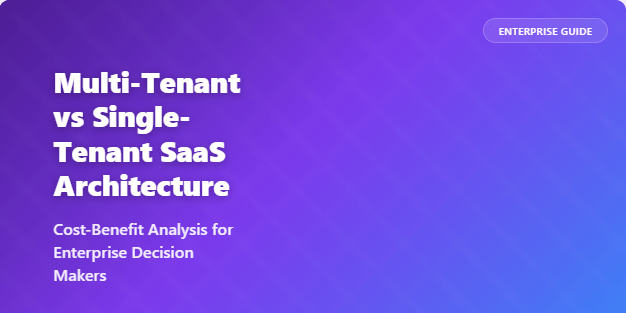
In the rapidly evolving landscape of cloud computing and Software as a Service (SaaS), enterprise organizations face critical decisions about their technology infrastructure that can significantly impact both operational efficiency and financial performance. Among the most important architectural choices is selecting between multi-tenant and single-tenant SaaS solutions.
This decision affects everything from initial deployment costs and ongoing operational expenses to security posture, customization capabilities, and scalability potential. As organizations increasingly rely on SaaS applications to drive their business processes, understanding the nuances between these two fundamental architectural approaches becomes essential for making informed, cost-effective decisions.
The choice between multi-tenant and single-tenant SaaS architectures is not merely a technical consideration—it’s a strategic business decision that influences long-term costs, operational flexibility, and competitive advantage. This comprehensive analysis will provide enterprise decision-makers with the insights needed to evaluate both options against their specific requirements, budget constraints, and organizational objectives.
Through examining real-world scenarios, cost structures, and implementation considerations, this guide will equip you with the knowledge to make an informed choice that aligns with your organization’s cloud management strategy and supports your digital transformation goals.
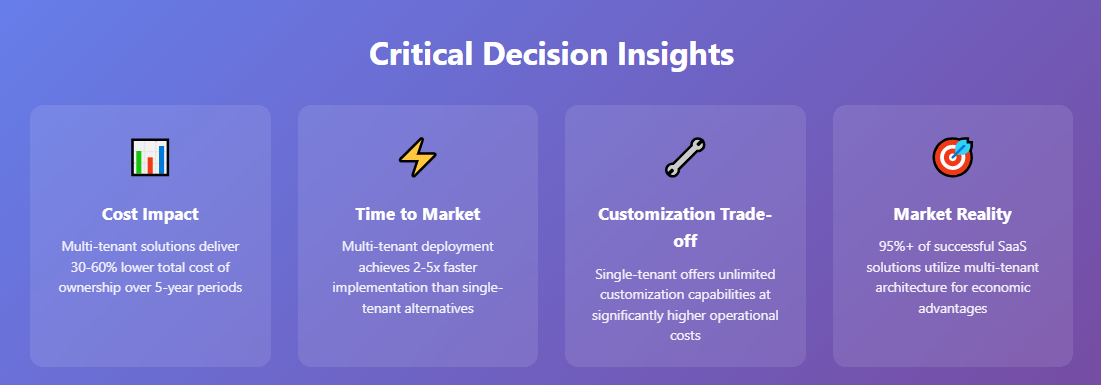
What is Multi-Tenant SaaS Architecture?
Multi-tenant SaaS architecture represents a software design approach where a single instance of an application serves multiple customers, or “tenants,” simultaneously. In this model, all tenants share the same infrastructure, database, and application code while maintaining logical separation of their data and configurations.
Think of multi-tenancy like a large apartment building where multiple families (tenants) live in separate units within the same structure, sharing common utilities and infrastructure like electricity, water, and building maintenance services. Each family has their own private space and belongings, but they benefit from shared resources and economies of scale.
Key Characteristics of Multi-Tenant Architecture
Shared Infrastructure: All customers utilize the same servers, databases, and application instances, which are managed by the SaaS provider. This shared approach enables significant cloud cost optimization through resource pooling and efficient utilization.
Data Isolation: Despite sharing infrastructure, each tenant’s data remains logically separated and secure. Advanced database partitioning techniques ensure that one tenant cannot access another’s information, maintaining privacy and compliance requirements.
Unified Maintenance: Updates, patches, and new features are deployed once across the entire platform, immediately benefiting all tenants. This approach reduces maintenance overhead and ensures consistent service delivery, similar to how cloud cost anomaly detection systems monitor shared resources for unusual patterns.
Resource Elasticity: The platform can dynamically allocate resources based on demand across all tenants, optimizing performance during peak usage periods and reducing costs during low-demand times.
Common Examples of Multi-Tenant SaaS
Popular multi-tenant SaaS applications include Salesforce CRM, Microsoft Office 365, Slack, and Zoom. These platforms serve millions of users simultaneously while maintaining individual account security and customization options.
What is Single-Tenant SaaS Architecture?
Single-tenant SaaS architecture provides each customer with their own dedicated instance of the software application, complete with separate infrastructure, databases, and in some cases, customized application code. This model offers the highest level of isolation and customization potential.
Using the housing analogy, single-tenancy is like owning a standalone house where you have complete control over the property, utilities, and modifications, but you’re also responsible for all maintenance costs and don’t benefit from shared economies of scale.
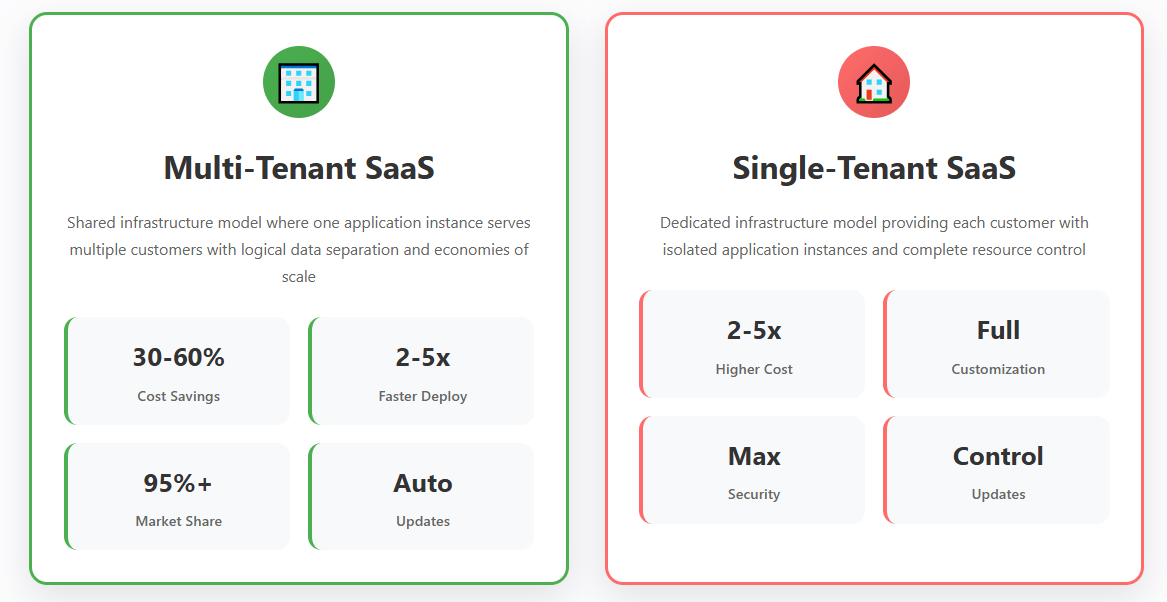
Key Characteristics of Single-Tenant Architecture
Dedicated Resources: Each customer receives their own dedicated servers, databases, and application instances, ensuring complete isolation from other customers. This approach provides predictable performance but typically results in higher per-customer infrastructure costs.
Enhanced Customization: Single-tenant environments allow for deep customization of the application, including custom workflows, integrations, and even modifications to the core application code to meet specific business requirements.
Independent Maintenance: Each tenant can have different update schedules, feature sets, and maintenance windows, providing flexibility for organizations with specific operational requirements or compliance needs. This approach requires careful IT resource management to ensure optimal performance and cost control.
Isolated Security: Complete infrastructure isolation provides the highest level of security, making it ideal for organizations handling sensitive data or operating in highly regulated industries.
Industries Favoring Single-Tenant Solutions
Healthcare organizations, financial institutions, government agencies, and large enterprises with complex compliance requirements often prefer single-tenant architectures for their enhanced security, customization capabilities, and regulatory compliance features.
Multi-Tenant vs. Single-Tenant: Key Differences
Understanding the fundamental differences between these architectural approaches is crucial for making an informed decision that aligns with your organization’s needs and budget.
Architecture and Infrastructure
Multi-tenant architecture leverages shared resources and economies of scale, similar to scalability in cloud computing principles. A single application instance serves multiple customers, with sophisticated data isolation mechanisms ensuring security and privacy. This shared approach enables providers to optimize resource utilization and reduce per-customer costs.
Single-tenant architecture provides complete isolation with dedicated resources for each customer. While this approach offers maximum control and customization potential, it requires significantly more infrastructure resources and management overhead.
Performance Characteristics
Multi-tenant systems can experience “noisy neighbor” effects where one tenant’s high resource usage impacts others sharing the same infrastructure. However, modern multi-tenant platforms implement sophisticated resource management and throttling mechanisms to minimize these issues.
Single-tenant systems provide predictable, dedicated performance since resources aren’t shared with other customers. This makes them ideal for applications with specific performance requirements or unpredictable usage patterns.
Customization and Flexibility
Multi-tenant platforms typically offer configuration-based customization through user interfaces, custom fields, workflows, and integrations. While these options can be extensive, they’re generally limited to what the platform’s architecture supports.
Single-tenant solutions enable deep customization, including modifications to the application code, database schema, and user interfaces. This level of flexibility makes them suitable for organizations with unique business processes that can’t be accommodated through standard configuration options.
Update and Maintenance Models
Multi-tenant platforms receive updates simultaneously across all tenants, ensuring everyone benefits from new features, security patches, and performance improvements immediately. This approach reduces the provider’s maintenance burden and ensures consistent service delivery.
Single-tenant customers can often control their update schedules, allowing them to test changes in staging environments and deploy updates during preferred maintenance windows. This flexibility is valuable for organizations with strict change control processes.
Cost Analysis: Multi-Tenant vs. Single-Tenant SaaS
The cost implications of choosing between multi-tenant and single-tenant architectures extend far beyond initial licensing fees and encompass total cost of ownership over the solution’s lifecycle.
Multi-Tenant Cost Structure
Lower Initial Costs: Multi-tenant solutions typically have lower upfront costs due to shared infrastructure expenses. Providers can offer competitive pricing by distributing costs across multiple customers, making affordable SaaS solutions accessible to organizations of all sizes.
Predictable Subscription Pricing: Most multi-tenant SaaS solutions follow standardized, per-user pricing models that make budgeting straightforward. This predictability supports effective SaaS spend management and financial planning.
Shared Infrastructure Benefits: Organizations benefit from economies of scale in infrastructure costs, maintenance, and support without bearing the full burden individually. Understanding cloud computing pricing models helps organizations evaluate these cost advantages effectively.
Limited Customization Costs: While customization options may be limited, the available configuration tools are typically included in the standard subscription price, avoiding additional development costs.
Single-Tenant Cost Structure
Higher Infrastructure Costs: Dedicated infrastructure significantly increases per-customer costs, as providers cannot distribute these expenses across multiple tenants. This often results in premium pricing that can be 2-5 times higher than multi-tenant alternatives.
Implementation and Customization Expenses: The ability to customize single-tenant solutions comes with associated costs for custom development, testing, and deployment. These projects can range from thousands to millions of dollars depending on complexity.
Ongoing Maintenance Overhead: Organizations may need to invest in additional IT resources to manage and maintain their dedicated environments, including monitoring, backup, and disaster recovery processes.
Update and Migration Costs: Unlike multi-tenant solutions where updates are automatic, single-tenant customers may incur costs for testing, validating, and deploying updates to their dedicated environments.
Total Cost of Ownership Comparison
When evaluating total cost of ownership over a 3-5 year period, consider these factors:
Multi-tenant TCO typically includes:
- Monthly or annual subscription fees
- User onboarding and training costs
- Integration development and maintenance
- Data migration and setup costs
Single-tenant TCO typically includes:
- Higher subscription or licensing fees
- Custom development and implementation costs
- Dedicated infrastructure and hosting expenses
- Ongoing maintenance and support costs
- Update and upgrade project costs
For most organizations, multi-tenant solutions provide significantly lower total cost of ownership, with savings often ranging from 30-60% compared to single-tenant alternatives.
Performance and Scalability Considerations
Performance requirements and scalability needs play crucial roles in determining the most suitable SaaS architecture for your organization.
Multi-Tenant Performance Characteristics
Multi-tenant platforms excel at handling variable workloads across diverse customer bases. The shared resource model enables dynamic resource allocation, automatically scaling to meet demand spikes while maintaining cost efficiency during low-usage periods.
However, multi-tenant systems can experience performance variability due to resource sharing. Peak usage by one large tenant might impact response times for others, though modern platforms implement sophisticated resource isolation and throttling mechanisms to minimize these effects.
Single-Tenant Performance Benefits
Single-tenant architectures provide predictable, dedicated performance since resources aren’t shared with other customers. This isolation ensures consistent response times and eliminates “noisy neighbor” concerns that can affect multi-tenant environments.
Organizations with mission-critical applications requiring guaranteed performance levels often prefer single-tenant solutions for their predictability and control over resource allocation.
Scalability Models
Multi-tenant platforms typically scale horizontally by adding more shared resources to serve the entire customer base. This approach is cost-effective but may require coordination across tenants for major scaling events.
Single-tenant solutions can scale independently for each customer, providing maximum flexibility but requiring individual resource management and planning for each tenant.
Security and Compliance Implications
Security considerations often drive architectural decisions, particularly for organizations in regulated industries or those handling sensitive data.
Multi-Tenant Security Framework
Modern multi-tenant SaaS platforms implement sophisticated security models that include data encryption, access controls, network isolation, and compliance certifications. Leading providers maintain security standards that often exceed what individual organizations could achieve independently.
The shared responsibility model for cloud security applies to multi-tenant SaaS, where providers handle infrastructure security while customers manage user access and data governance.
Single-Tenant Security Advantages
Single-tenant architectures provide the highest level of isolation, with dedicated infrastructure eliminating many attack vectors present in shared environments. This isolation is particularly valuable for organizations with strict compliance requirements or those handling highly sensitive data.
However, single-tenant customers bear more responsibility for security configuration and maintenance, requiring additional expertise and resources to maintain adequate protection levels. Organizations should consider implementing comprehensive cloud security best practices regardless of the chosen architecture.
Compliance Considerations
Many regulatory frameworks accept multi-tenant SaaS solutions when proper controls are implemented. Providers often maintain certifications for standards like SOC 2, ISO 27001, HIPAA, and PCI DSS across their platforms.
Single-tenant solutions may be required for specific regulations or organizational policies that mandate complete data isolation, but these requirements are becoming less common as multi-tenant security capabilities improve. Organizations should review cloud compliance regulations and best practices when evaluating security requirements.
Customization and Integration Capabilities
The level of customization required often determines which architectural approach best fits an organization’s needs.
Multi-Tenant Customization Options
Multi-tenant platforms typically offer extensive configuration capabilities through user interfaces, including custom fields, workflows, reports, and dashboards. Many also provide APIs and integration platforms for connecting with other systems.
While these customization options can be comprehensive, they’re generally limited to what the platform’s architecture supports. Organizations with unique requirements that fall outside these boundaries may find multi-tenant solutions restrictive.
Single-Tenant Customization Freedom
Single-tenant architectures enable virtually unlimited customization, including modifications to the application code, database schema, user interfaces, and business logic. This flexibility makes them ideal for organizations with complex, unique business processes.
However, extensive customizations can create technical debt and complicate future updates, potentially leading to higher long-term maintenance costs and reduced agility.
Integration Capabilities
Both architectures typically offer robust integration capabilities, but with different approaches. Multi-tenant platforms often provide standardized APIs and pre-built connectors that serve the majority of integration needs efficiently.
Single-tenant solutions can support custom integrations and modifications that aren’t possible in multi-tenant environments, but these often require additional development and maintenance resources.
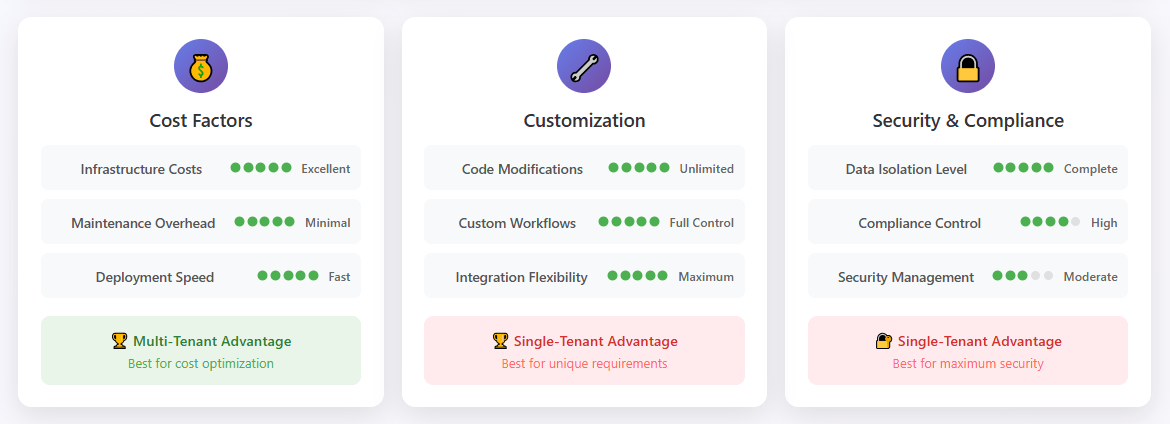
Industry-Specific Considerations
Different industries have varying requirements that influence the choice between multi-tenant and single-tenant architectures.
Healthcare and Life Sciences
Healthcare organizations often require HIPAA compliance and strict data isolation. While many modern multi-tenant platforms support HIPAA compliance, some healthcare organizations prefer single-tenant solutions for additional security and compliance assurance.
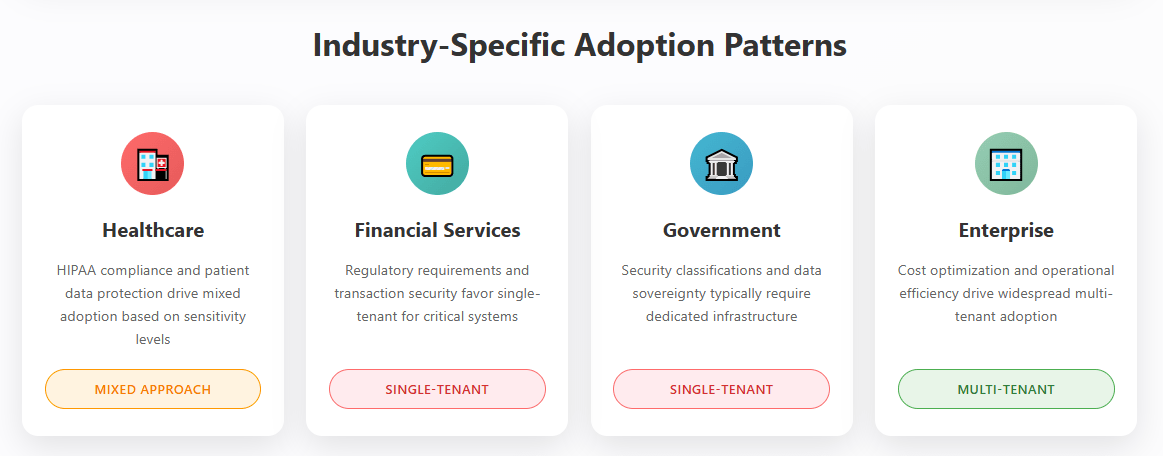
Financial Services
Financial institutions typically have stringent regulatory requirements and security standards. Both architectures can meet these requirements, but the choice often depends on specific regulatory interpretations and internal security policies.
Government and Defense
Government agencies often require single-tenant solutions due to security classifications, compliance requirements, and data sovereignty needs. However, some government organizations are adopting multi-tenant solutions for non-sensitive applications.
Understanding the specific requirements for cloud computing in regulated industries helps inform architecture decisions for public sector organizations.
Manufacturing and Enterprise
Large enterprises with complex business processes may benefit from single-tenant customization capabilities, while smaller organizations often find multi-tenant solutions provide adequate functionality at lower costs.
Best Practices for Enterprise Decision Making
Making the right choice between multi-tenant and single-tenant SaaS requires a systematic evaluation process that considers multiple factors.

Assessment Framework
Requirements Analysis: Document your organization’s specific functional requirements, security needs, compliance obligations, and integration requirements. This analysis should identify must-have versus nice-to-have capabilities.
Cost-Benefit Evaluation: Develop a comprehensive total cost of ownership model that includes all direct and indirect costs over a 3-5 year period. Consider both immediate expenses and long-term operational costs.
Risk Assessment: Evaluate security, compliance, and operational risks associated with each approach. Consider your organization’s risk tolerance and mitigation capabilities.
Scalability Planning: Assess your expected growth patterns and scalability requirements. Consider both user growth and data volume increases over time.
Decision Criteria
Choose multi-tenant SaaS when:
- Cost optimization is a primary concern
- Standard functionality meets most requirements
- Rapid deployment is needed
- Limited IT resources for management and maintenance
- Regulatory requirements can be met through shared tenancy
Choose single-tenant SaaS when:
- Extensive customization is required
- Maximum security and data isolation is needed
- Specific compliance requirements mandate dedicated infrastructure
- Predictable performance is critical
- Budget allows for higher costs
Hybrid Considerations
Some organizations implement hybrid approaches, using multi-tenant solutions for standard applications and single-tenant solutions for mission-critical or highly customized systems. This strategy can optimize costs while meeting specific requirements where needed.
Organizations should also consider how Shadow IT risks and benefits might influence their architecture decisions, as different tenancy models offer varying levels of control over unauthorized application usage.
Managing Multi-Tenant and Single-Tenant SaaS Costs with Binadox
Regardless of which architectural approach you choose, effective SaaS spend management becomes crucial for controlling costs and maximizing value from your software investments.
Binadox provides comprehensive visibility and control over both multi-tenant and single-tenant SaaS expenditures through a centralized management platform. Our solution helps organizations discover all SaaS applications in use, track spending across different tenancy models, and optimize subscriptions based on actual usage patterns.
Key Benefits for Multi-Tenant SaaS Management
Usage Monitoring: Track user adoption and feature utilization across multi-tenant applications to identify optimization opportunities and eliminate unused licenses.
Subscription Optimization: Right-size subscriptions based on actual usage patterns, avoiding over-provisioning that commonly occurs in user-based pricing models.
Renewal Management: Proactively manage renewal dates and contract terms to negotiate better pricing and avoid automatic renewals for underutilized services.
Key Benefits for Single-Tenant SaaS Management
Cost Allocation: Track and allocate single-tenant SaaS costs across departments, projects, or business units for accurate cost accounting and budgeting.
Custom Contract Tracking: Monitor complex single-tenant contracts with custom terms, pricing structures, and service level agreements.
ROI Analysis: Evaluate the return on investment for expensive single-tenant solutions by correlating costs with business outcomes and usage metrics.
Unified SaaS Portfolio Management
Binadox enables organizations to manage hybrid SaaS portfolios that include both multi-tenant and single-tenant solutions through a single dashboard. This unified approach provides complete visibility into your software spending and helps optimize the mix of tenancy models based on actual business value and cost-effectiveness.
Our platform integrates with popular financial and procurement systems to provide automated invoice processing, budget tracking, and spend analytics that support data-driven decisions about SaaS architecture choices and vendor negotiations.
Conclusion
The choice between multi-tenant and single-tenant SaaS architectures represents a critical strategic decision that impacts both immediate costs and long-term operational efficiency. While multi-tenant solutions offer compelling advantages in cost-effectiveness, ease of deployment, and reduced maintenance overhead, single-tenant architectures provide unmatched customization capabilities, security isolation, and performance predictability.
For most enterprise organizations, multi-tenant SaaS solutions provide the optimal balance of functionality, cost-effectiveness, and operational simplicity. The shared infrastructure model enables significant cost savings while modern security and isolation technologies address most compliance and security concerns effectively.
However, organizations with unique business processes, strict regulatory requirements, or specific performance needs may find single-tenant solutions justify their higher costs through enhanced customization capabilities and dedicated resource allocation.
The key to making the right decision lies in conducting a thorough analysis of your organization’s specific requirements, risk tolerance, and budget constraints. Consider not just the immediate functional needs, but also the long-term implications for scalability, maintenance, and total cost of ownership.
As the SaaS ecosystem continues to evolve, the gap between multi-tenant and single-tenant capabilities is narrowing. Multi-tenant platforms are incorporating more customization options and enhanced security features, while single-tenant solutions are becoming more standardized and cost-effective through improved deployment automation and management tools.
Regardless of which architectural approach you choose, implementing effective SaaS spend management practices is essential for maximizing the value of your software investments. Tools like Binadox provide the visibility and control needed to optimize costs, manage renewals, and ensure your SaaS portfolio continues to deliver value as your organization grows and evolves.
By carefully evaluating your requirements against the benefits and limitations of each approach, you can make an informed decision that supports your organization’s digital transformation goals while maintaining cost-effectiveness and operational efficiency in an increasingly cloud-centric business environment.

